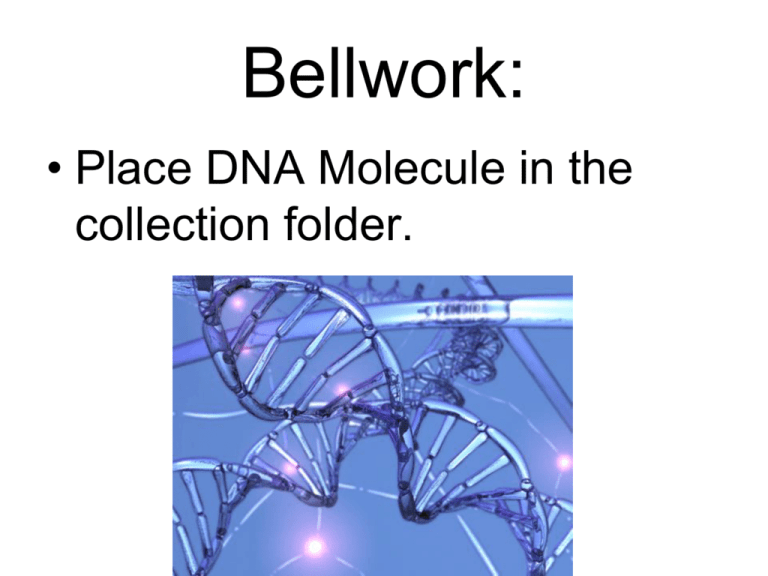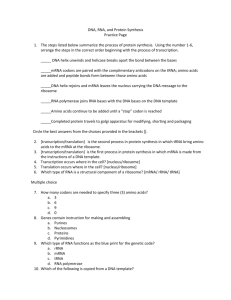DNA to Protein
advertisement

Bellwork: • Place DNA Molecule in the collection folder. Describe how the structure of DNA relates to its function. DNA Replication DNA Replication • • • • http://www.youtube.com/watch?v=hfZ8o9D1tus http://www.youtube.com/watch?v=4jtmOZaIvS0 http://www.johnkyrk.com/DNAreplication.html http://highered.mcgrawhill.com/sites/0072437316/student_view0/chapter 14/animations.html# From DNA to Protein Using the information encoded in the DNA to: Producing Proteins! = “Protein Synthesis” Why are Proteins Important? --help build cell organelles (cell membrane) --are used as enzymes to promote reactions --are found in muscles, blood, skin, bones, etc. Figure UN15-5 (information storage) Transcription (information carrier) Translation (active cell machinery) Making a protein is like reading a library book. Cell Neighborhood Nucleus Library ----------------------------------------------------------------- --------------------------------- Homework Making a protein is like reading a library book. Cell Neighborhood Cytoplasm Nucleus Library ? New Protein --------------------------------- Home ? Homework Information Flows in One Direction: DNA RNA Proteins. Transcription (Nucleus) Translation (Cytoplasm) Transcription: A modified copy of the DNA A. Keeping the DNA ‘encyclopedia’ safe in the nucleus. B. Copying only the necessary information (‘pages’). C. Only when the information is required. DNA and RNA Compare DNA to RNA: Structure # of Strands: Sugar: Bases: DNA RNA 2 1 Deoxy- Ribose Ribose ACGT ACGU Thymine Uracil TRANSCRIPTION translation Takes place in the nucleus Moves out of nucleus into the cytoplasm & attach to ribosome (information storage) Transcription (information carrier) Translation (active cell machinery) RIBONUCLEIC ACID (RNA) • HOW IS RNA DIFFERENT FROM DNA?? Let’s review DNA •Contains the sugar DEOXYRibose • ADENINE pairs with Thymine • GUANINE pairs with Cytosine •Double Stranded RNA is different from DNA… •Contains the sugar Ribose • Uracil Substitutes for Thymine (A pairs with U) •Single Stranded Fill in Your Chart… Differences Between DNA and RNA: DNA RNA SUGAR Deoxyribose Ribose NITROGEN BASES A, T, C, G A, Uracil, C, G SHAPE Double Helix Single Strand • RNA is the same structure as DNA, it is rearranged in the complementary order. DNA = A T T G C A C RNA = U A A C G U G How is RNA made? Through TRANSCRIPTION! Here’s a Summary: Transcription: RNA is made from DNA to use during protein synthesis. Same process as replication, but only one side of the DNA strand is copied. This occurs in the nucleus. When RNA is made it leaves the nucleus (through pores in the membrane) and the DNA strand zips back up. Why is RNA important? • It contains the code from DNA that is needed to make proteins! What are proteins? • Organic Compounds that are made from amino acids linked together by covalent, peptide bonds Ex. AA1 + AA2 + AA3 = a protein/ polypeptide Why are Proteins Important? --help build cell organelles (cell membrane) --are used as enzymes to promote reactions --are found in muscles, blood, skin, bones, etc. Three Types of RNA • Messenger RNA (mRNA) – transcribes the code from DNA and takes it from the nucleus into the cytoplasm to the ribosome. • Transfer RNA(tRNA) – translates the message by transferring amino acids from the cytoplasm to the ribosomes to the mRNA. • Ribosomal RNA (rRNA) – structural component of ribosome that binds mRNA and tRNA together; makes up 80% of all RNA in the cell. Protein Synthesis – THE MAKING OF PROTEINS 2 Processes in Protein Synthesis • Transcription • Translation Transcription mRNA copies the code from DNA TRANSCRIPTION – the details Transcription • Segments of DNA are separated by RNA polymerase, one of the strands is used as a template to make the molecule of mRNA • RNA polymerase adds mRNA nucleotides as it reads the code and binds them with their complementary nucleotides on the DNA LET’S DO TRANSCRIPTION! DNA = A mRNA = U G C C G T A G C A U TRANSCRIPTION •The base sequence in mRNA is a code that enables the tRNA to collect the right amino acids and assemble them in the correct sequence to synthesize a protein. •Codon: Every combination of three “letters” (nitrogen bases). • 1 CODON = 1 AMINO ACID = 3 NUCLEOTIDES what do the codons code for? The genetic codethe correspondence between triplets in DNA and the amino acids in proteins Each amino acid is coded for by 3 mRNA bases arranged in a specific sequence Translation (tRNA) • Translates the mRNA bases into amino acids that will make up a protein. • Ribosome attaches to the mRNA • tRNA picks up specific amino acids in the cytoplasm and carries them to the mRNA at the ribosomes •tRNA contains the anticodon that complements the codon on the mRNA TRANSLATION— The Details 1. mRNA strand (made of codons) leaves the nucleus, enters cytoplasm, attaches to ribosome 2. tRNA molecules pick up amino acids in cytoplasm and carries them to ribosome 3. tRNA anticodon pairs with mRNA codon, joining the two molecules 4. When 2 amino acids are in place a polypeptide bond forms 5. Once an amino acid has joined the chain, the tRNA detaches from the mRNA strand 6. The process continues until a chain of amino acids is formed and stops once a stop codon on the mRNA is reached. 7. The chain of amino acids is called a protein or polypeptide. TRANSLATION (tRNA) • DNA =A T G C T A • mRNA = U A C G A U (Codon) • tRNA = A U G C U A (Anticodon) Let’s summArize Protein synthesis! TRANSCRIPTION translation Takes place in the nucleus Moves out of nucleus into the cytoplasm & attach to ribosome SUMMARY: 5 Steps of Protein Synthesis 1. Transcription: DNA makes RNA (in the nucleus) 2. RNA now becomes mRNA which will leave the nucleus (take the code to ribosome) 3. mRNA tells ribosomes what proteins to make 4. mRNA attaches to ribosome and forms a pattern (codon) to make a protein 5. tRNA in cytoplasm comes to ribosome. It “translates” the code (codon=three base pairs) and goes and gets the specific amino acid that matches up with the codon. This is the anticodon. When amino acids are combined together (by covalent, peptide bonds) they break off and form the specific protein needed by the cell. This part is called Translation. Steps to figure out the genetic code 1. Obtain a DNA Template. (a row of DNA bases) 2. Transcribe DNA into mRNA 3. Translate mRNA into tRNA 4. Use the codons (mRNA) to translate into amino acids Why do some amino acids have more than one code? • 4 nucleotide bases, 3 at a time = 43 = 64 • 20 different amino acids and 64 code words, so some AA are specified by more than one code word. Let’s prActice! DNA ATG mRNA (Codon) UAC tRNA Strand (anticodon) AUG Amino Acids Tyrosine More practice needed? DNA= TAC -GAT-GCC-ATC -CUA- CGG-UAG mRNA= AUG ________________ tRNA= ________________ UAC -GAU-GCC-AUC START-LEU-ARG-STOP Amino Acids= _________________








